TRU Statistics Homework: Hypothesis Testing Problems and Solutions
VerifiedAdded on 2022/09/09
|7
|1119
|21
Homework Assignment
AI Summary
This document presents solutions to a statistics homework assignment, focusing on hypothesis testing. The solutions cover a range of statistical tests, including one-sample Z-tests, one-sample T-tests, F-tests for variance, two-sample T-tests, and two-sample Z-tests. Each problem includes a detai...
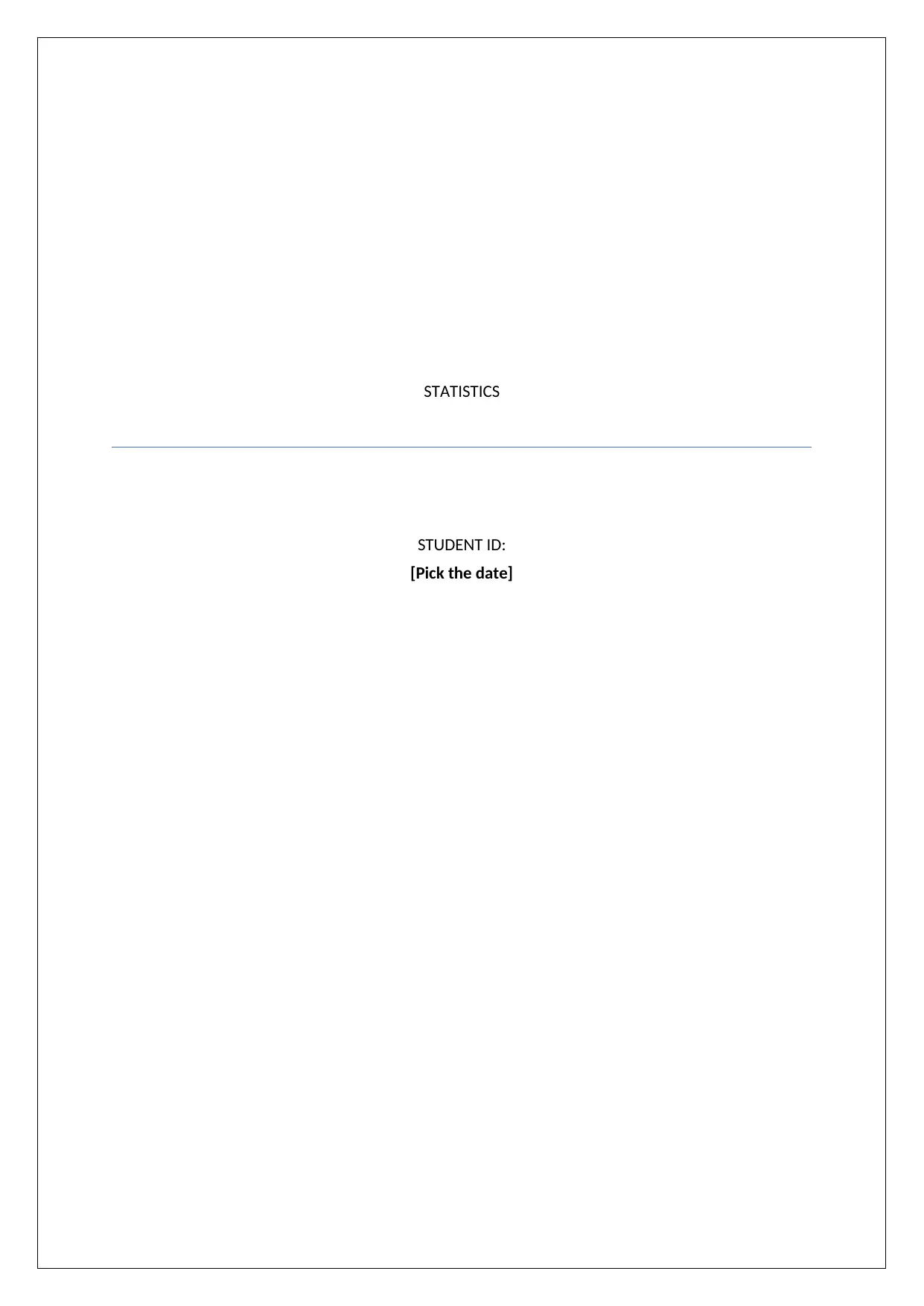
STATISTICS
STUDENT ID:
[Pick the date]
STUDENT ID:
[Pick the date]
Paraphrase This Document
Need a fresh take? Get an instant paraphrase of this document with our AI Paraphraser
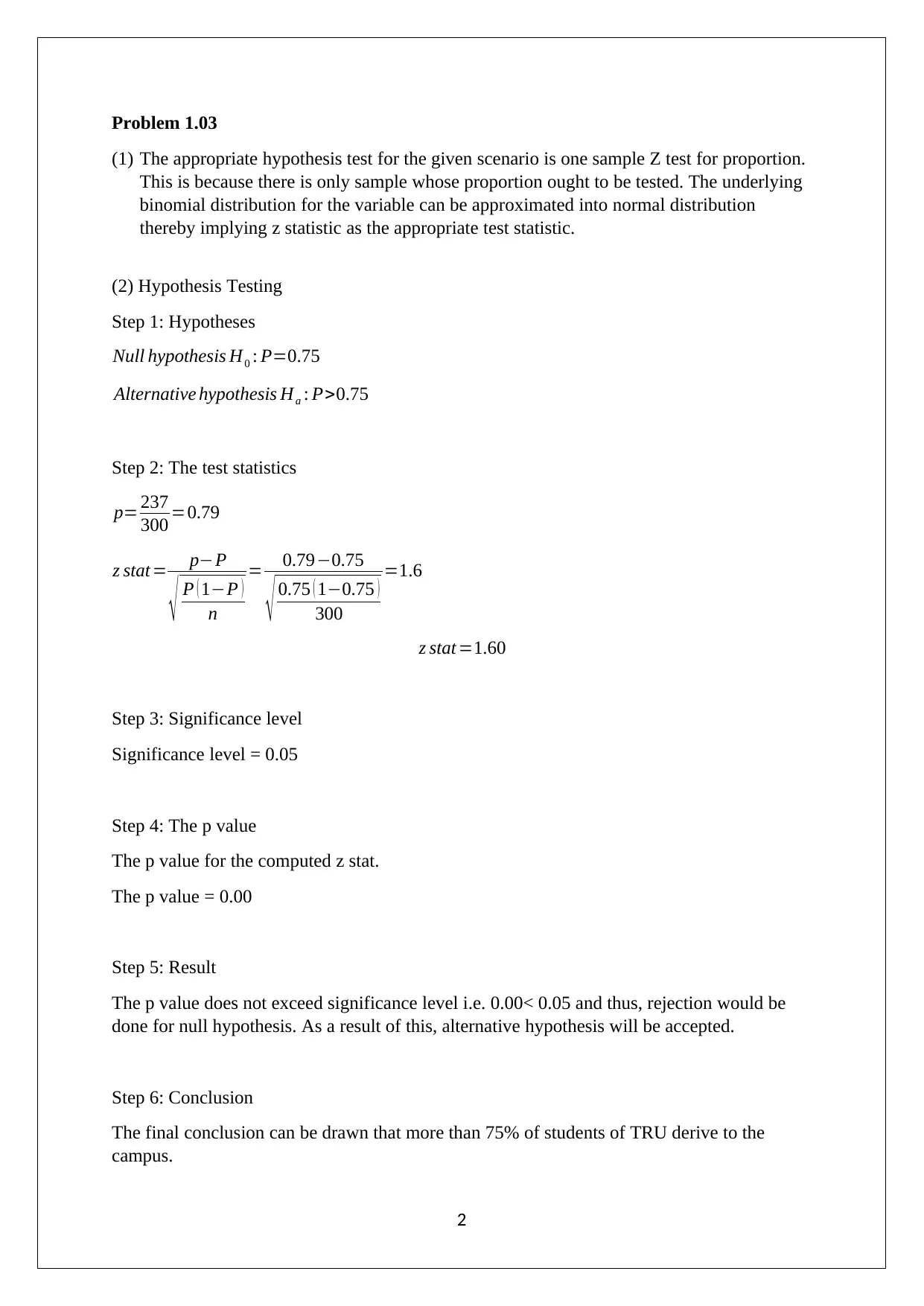
Problem 1.03
(1) The appropriate hypothesis test for the given scenario is one sample Z test for proportion.
This is because there is only sample whose proportion ought to be tested. The underlying
binomial distribution for the variable can be approximated into normal distribution
thereby implying z statistic as the appropriate test statistic.
(2) Hypothesis Testing
Step 1: Hypotheses
Null hypothesis H0 : P=0.75
Alternative hypothesis Ha : P>0.75
Step 2: The test statistics
p= 237
300 =0.79
z stat = p−P
√ P ( 1−P )
n
= 0.79−0.75
√ 0.75 ( 1−0.75 )
300
=1.6
z stat =1.60
Step 3: Significance level
Significance level = 0.05
Step 4: The p value
The p value for the computed z stat.
The p value = 0.00
Step 5: Result
The p value does not exceed significance level i.e. 0.00< 0.05 and thus, rejection would be
done for null hypothesis. As a result of this, alternative hypothesis will be accepted.
Step 6: Conclusion
The final conclusion can be drawn that more than 75% of students of TRU derive to the
campus.
2
(1) The appropriate hypothesis test for the given scenario is one sample Z test for proportion.
This is because there is only sample whose proportion ought to be tested. The underlying
binomial distribution for the variable can be approximated into normal distribution
thereby implying z statistic as the appropriate test statistic.
(2) Hypothesis Testing
Step 1: Hypotheses
Null hypothesis H0 : P=0.75
Alternative hypothesis Ha : P>0.75
Step 2: The test statistics
p= 237
300 =0.79
z stat = p−P
√ P ( 1−P )
n
= 0.79−0.75
√ 0.75 ( 1−0.75 )
300
=1.6
z stat =1.60
Step 3: Significance level
Significance level = 0.05
Step 4: The p value
The p value for the computed z stat.
The p value = 0.00
Step 5: Result
The p value does not exceed significance level i.e. 0.00< 0.05 and thus, rejection would be
done for null hypothesis. As a result of this, alternative hypothesis will be accepted.
Step 6: Conclusion
The final conclusion can be drawn that more than 75% of students of TRU derive to the
campus.
2
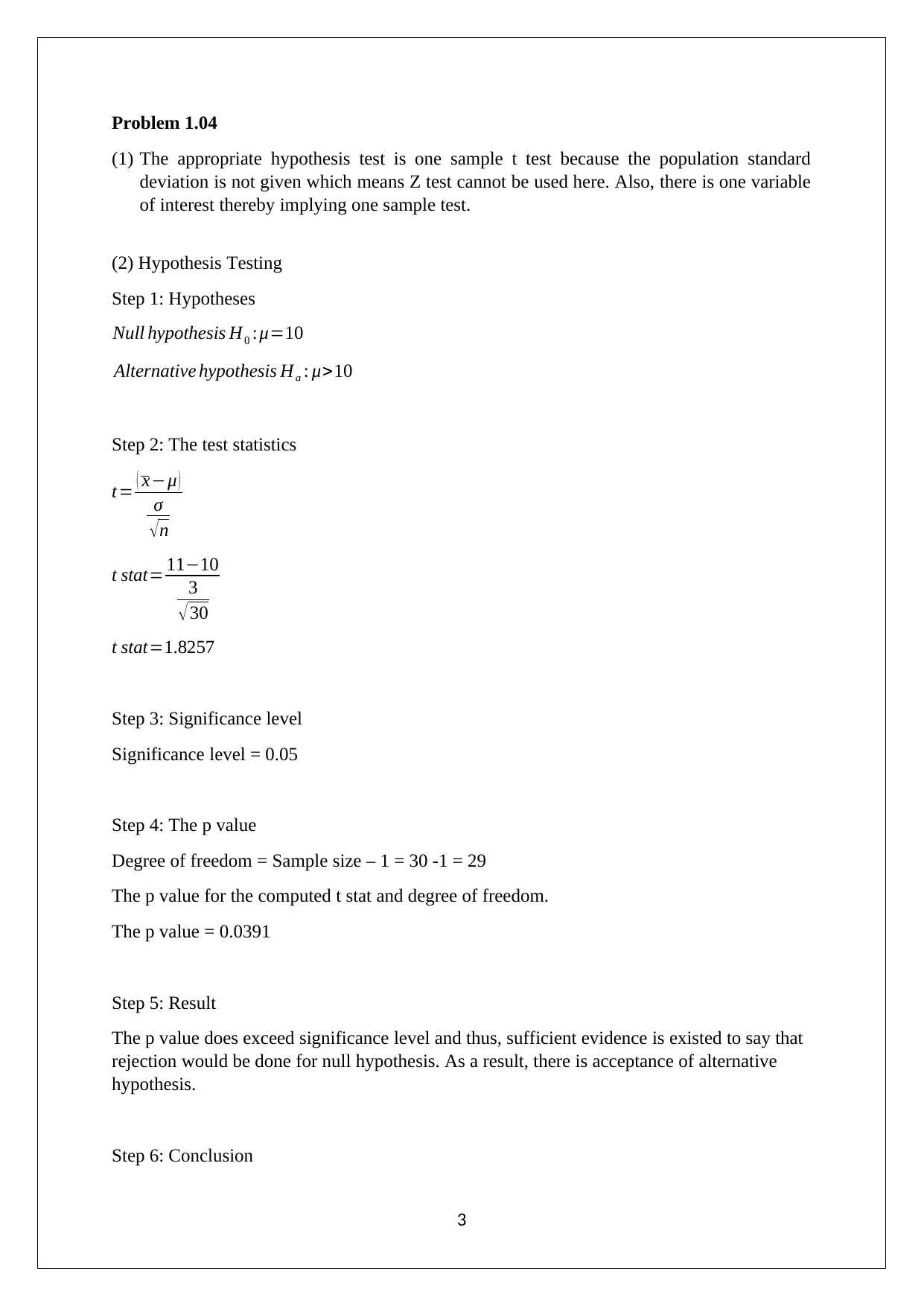
Problem 1.04
(1) The appropriate hypothesis test is one sample t test because the population standard
deviation is not given which means Z test cannot be used here. Also, there is one variable
of interest thereby implying one sample test.
(2) Hypothesis Testing
Step 1: Hypotheses
Null hypothesis H0 :μ=10
Alternative hypothesis Ha : μ>10
Step 2: The test statistics
t= ( x−μ )
σ
√n
t stat= 11−10
3
√ 30
t stat=1.8257
Step 3: Significance level
Significance level = 0.05
Step 4: The p value
Degree of freedom = Sample size – 1 = 30 -1 = 29
The p value for the computed t stat and degree of freedom.
The p value = 0.0391
Step 5: Result
The p value does exceed significance level and thus, sufficient evidence is existed to say that
rejection would be done for null hypothesis. As a result, there is acceptance of alternative
hypothesis.
Step 6: Conclusion
3
(1) The appropriate hypothesis test is one sample t test because the population standard
deviation is not given which means Z test cannot be used here. Also, there is one variable
of interest thereby implying one sample test.
(2) Hypothesis Testing
Step 1: Hypotheses
Null hypothesis H0 :μ=10
Alternative hypothesis Ha : μ>10
Step 2: The test statistics
t= ( x−μ )
σ
√n
t stat= 11−10
3
√ 30
t stat=1.8257
Step 3: Significance level
Significance level = 0.05
Step 4: The p value
Degree of freedom = Sample size – 1 = 30 -1 = 29
The p value for the computed t stat and degree of freedom.
The p value = 0.0391
Step 5: Result
The p value does exceed significance level and thus, sufficient evidence is existed to say that
rejection would be done for null hypothesis. As a result, there is acceptance of alternative
hypothesis.
Step 6: Conclusion
3
⊘ This is a preview!⊘
Do you want full access?
Subscribe today to unlock all pages.

Trusted by 1+ million students worldwide

The claim is true that the fuel efficiency of vehicle exceeds 10L/100KM.
Problem 1.05
1) It is noteworthy that T based or Z based test are used when the objective is to test
hypothesis regarding mean. However, in the given case, the variance of two variables need
to be compared which implies that the appropriate test would be F test for testing of
variance.
2) Hypothesis Testing
Step 1: Hypotheses
Null hypothesis H0 :σ(1900−1999)
2 =σ(1800−1899)
2
Alternative hypothesis Ha :σ(1900−1999)
2 > σ(1800−1899)
2
Step 2: The test statistics
F stat= s(1900−1999 )
2
s(1800−1899 )
2
F stat= 202
122 =2.77 8
Step 3: Significance level
Significance level = 0.05
Step 4: The p value
Degree of freedom of numerator = N1– 1 = 30 -1 = 29
Denominator of freedom of numerator = N2– 1 = 13 -1 = 12
The p value for the computed F stat and degree of freedom.
The p value = 0.03243
Step 5: Result
The p value is not higher than the significance level and thus, null hypothesis will easily be
rejected and hence, the acceptance would be made for alternative hypothesis.
4
Problem 1.05
1) It is noteworthy that T based or Z based test are used when the objective is to test
hypothesis regarding mean. However, in the given case, the variance of two variables need
to be compared which implies that the appropriate test would be F test for testing of
variance.
2) Hypothesis Testing
Step 1: Hypotheses
Null hypothesis H0 :σ(1900−1999)
2 =σ(1800−1899)
2
Alternative hypothesis Ha :σ(1900−1999)
2 > σ(1800−1899)
2
Step 2: The test statistics
F stat= s(1900−1999 )
2
s(1800−1899 )
2
F stat= 202
122 =2.77 8
Step 3: Significance level
Significance level = 0.05
Step 4: The p value
Degree of freedom of numerator = N1– 1 = 30 -1 = 29
Denominator of freedom of numerator = N2– 1 = 13 -1 = 12
The p value for the computed F stat and degree of freedom.
The p value = 0.03243
Step 5: Result
The p value is not higher than the significance level and thus, null hypothesis will easily be
rejected and hence, the acceptance would be made for alternative hypothesis.
4
Paraphrase This Document
Need a fresh take? Get an instant paraphrase of this document with our AI Paraphraser
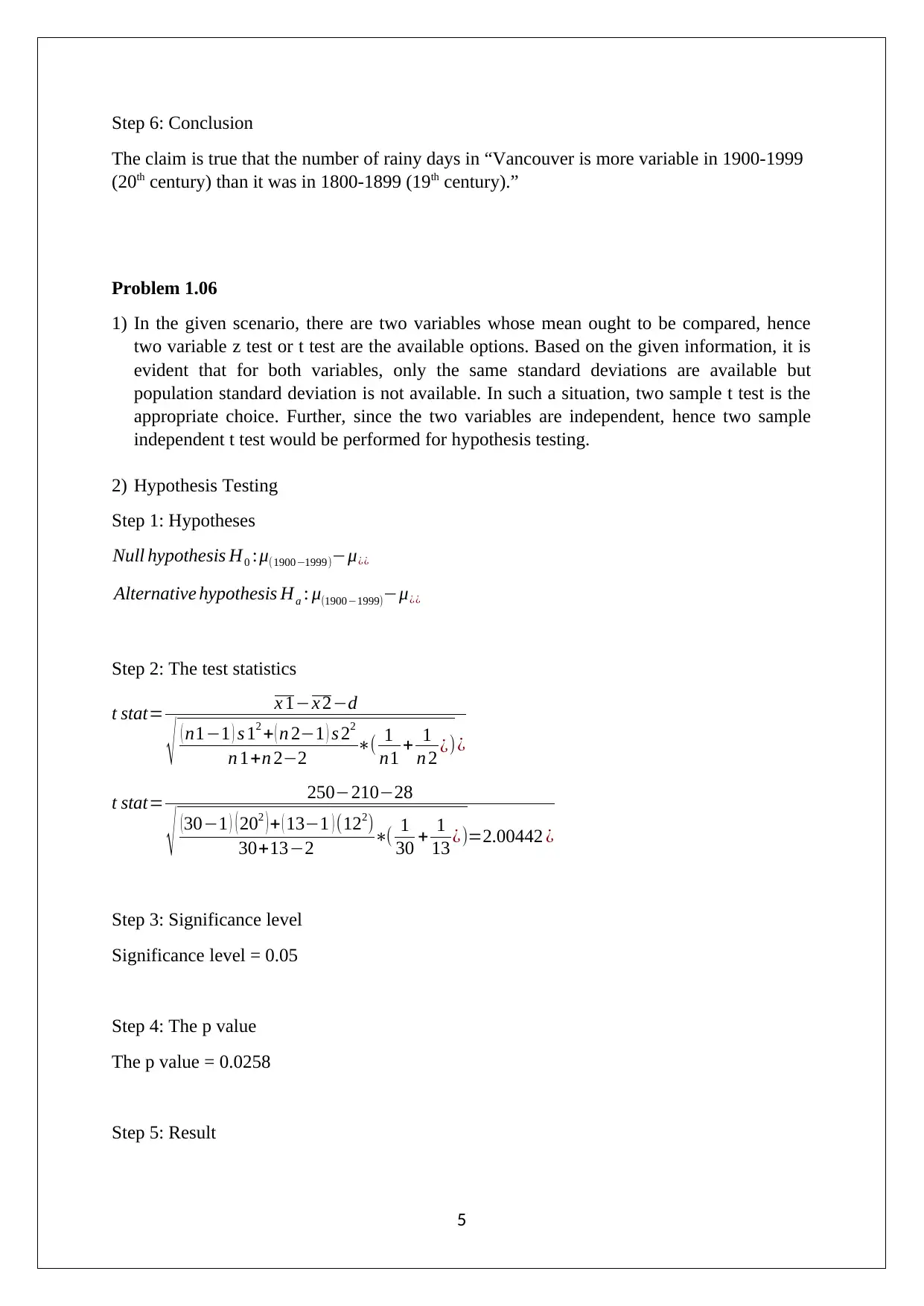
Step 6: Conclusion
The claim is true that the number of rainy days in “Vancouver is more variable in 1900-1999
(20th century) than it was in 1800-1899 (19th century).”
Problem 1.06
1) In the given scenario, there are two variables whose mean ought to be compared, hence
two variable z test or t test are the available options. Based on the given information, it is
evident that for both variables, only the same standard deviations are available but
population standard deviation is not available. In such a situation, two sample t test is the
appropriate choice. Further, since the two variables are independent, hence two sample
independent t test would be performed for hypothesis testing.
2) Hypothesis Testing
Step 1: Hypotheses
Null hypothesis H0 :μ(1900−1999)−μ¿¿
Alternative hypothesis Ha : μ(1900−1999)−μ¿¿
Step 2: The test statistics
t stat= x 1−x 2−d
√ ( n1−1 ) s 12 + ( n 2−1 ) s 22
n 1+n 2−2 ∗( 1
n1 + 1
n 2 ¿)¿
t stat= 250−210−28
√ (30−1 ) ( 202 ) + ( 13−1 ) (122)
30+13−2 ∗( 1
30 + 1
13 ¿)=2.00442 ¿
Step 3: Significance level
Significance level = 0.05
Step 4: The p value
The p value = 0.0258
Step 5: Result
5
The claim is true that the number of rainy days in “Vancouver is more variable in 1900-1999
(20th century) than it was in 1800-1899 (19th century).”
Problem 1.06
1) In the given scenario, there are two variables whose mean ought to be compared, hence
two variable z test or t test are the available options. Based on the given information, it is
evident that for both variables, only the same standard deviations are available but
population standard deviation is not available. In such a situation, two sample t test is the
appropriate choice. Further, since the two variables are independent, hence two sample
independent t test would be performed for hypothesis testing.
2) Hypothesis Testing
Step 1: Hypotheses
Null hypothesis H0 :μ(1900−1999)−μ¿¿
Alternative hypothesis Ha : μ(1900−1999)−μ¿¿
Step 2: The test statistics
t stat= x 1−x 2−d
√ ( n1−1 ) s 12 + ( n 2−1 ) s 22
n 1+n 2−2 ∗( 1
n1 + 1
n 2 ¿)¿
t stat= 250−210−28
√ (30−1 ) ( 202 ) + ( 13−1 ) (122)
30+13−2 ∗( 1
30 + 1
13 ¿)=2.00442 ¿
Step 3: Significance level
Significance level = 0.05
Step 4: The p value
The p value = 0.0258
Step 5: Result
5
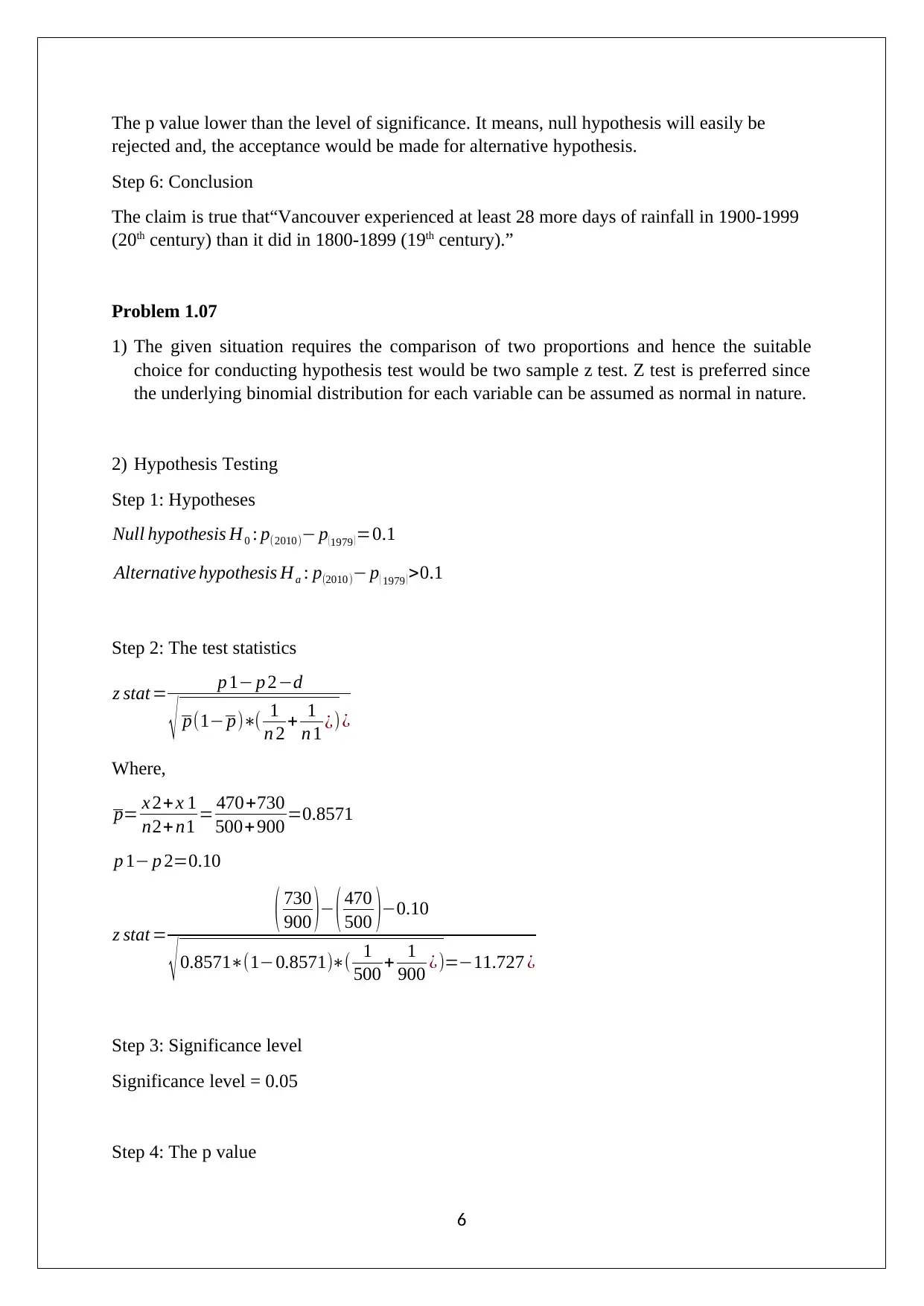
The p value lower than the level of significance. It means, null hypothesis will easily be
rejected and, the acceptance would be made for alternative hypothesis.
Step 6: Conclusion
The claim is true that“Vancouver experienced at least 28 more days of rainfall in 1900-1999
(20th century) than it did in 1800-1899 (19th century).”
Problem 1.07
1) The given situation requires the comparison of two proportions and hence the suitable
choice for conducting hypothesis test would be two sample z test. Z test is preferred since
the underlying binomial distribution for each variable can be assumed as normal in nature.
2) Hypothesis Testing
Step 1: Hypotheses
Null hypothesis H0 : p(2010)− p ( 1979 ) =0.1
Alternative hypothesis Ha : p(2010)− p ( 1979 ) >0.1
Step 2: The test statistics
z stat = p 1− p 2−d
√ p(1− p)∗( 1
n 2 + 1
n 1 ¿)¿
Where,
p= x 2+x 1
n2+n1 = 470+730
500+ 900 =0.8571
p 1− p 2=0.10
z stat = ( 730
900 )− ( 470
500 )−0.10
√ 0.8571∗(1−0.8571)∗( 1
500 + 1
900 ¿)=−11.727 ¿
Step 3: Significance level
Significance level = 0.05
Step 4: The p value
6
rejected and, the acceptance would be made for alternative hypothesis.
Step 6: Conclusion
The claim is true that“Vancouver experienced at least 28 more days of rainfall in 1900-1999
(20th century) than it did in 1800-1899 (19th century).”
Problem 1.07
1) The given situation requires the comparison of two proportions and hence the suitable
choice for conducting hypothesis test would be two sample z test. Z test is preferred since
the underlying binomial distribution for each variable can be assumed as normal in nature.
2) Hypothesis Testing
Step 1: Hypotheses
Null hypothesis H0 : p(2010)− p ( 1979 ) =0.1
Alternative hypothesis Ha : p(2010)− p ( 1979 ) >0.1
Step 2: The test statistics
z stat = p 1− p 2−d
√ p(1− p)∗( 1
n 2 + 1
n 1 ¿)¿
Where,
p= x 2+x 1
n2+n1 = 470+730
500+ 900 =0.8571
p 1− p 2=0.10
z stat = ( 730
900 )− ( 470
500 )−0.10
√ 0.8571∗(1−0.8571)∗( 1
500 + 1
900 ¿)=−11.727 ¿
Step 3: Significance level
Significance level = 0.05
Step 4: The p value
6
⊘ This is a preview!⊘
Do you want full access?
Subscribe today to unlock all pages.

Trusted by 1+ million students worldwide
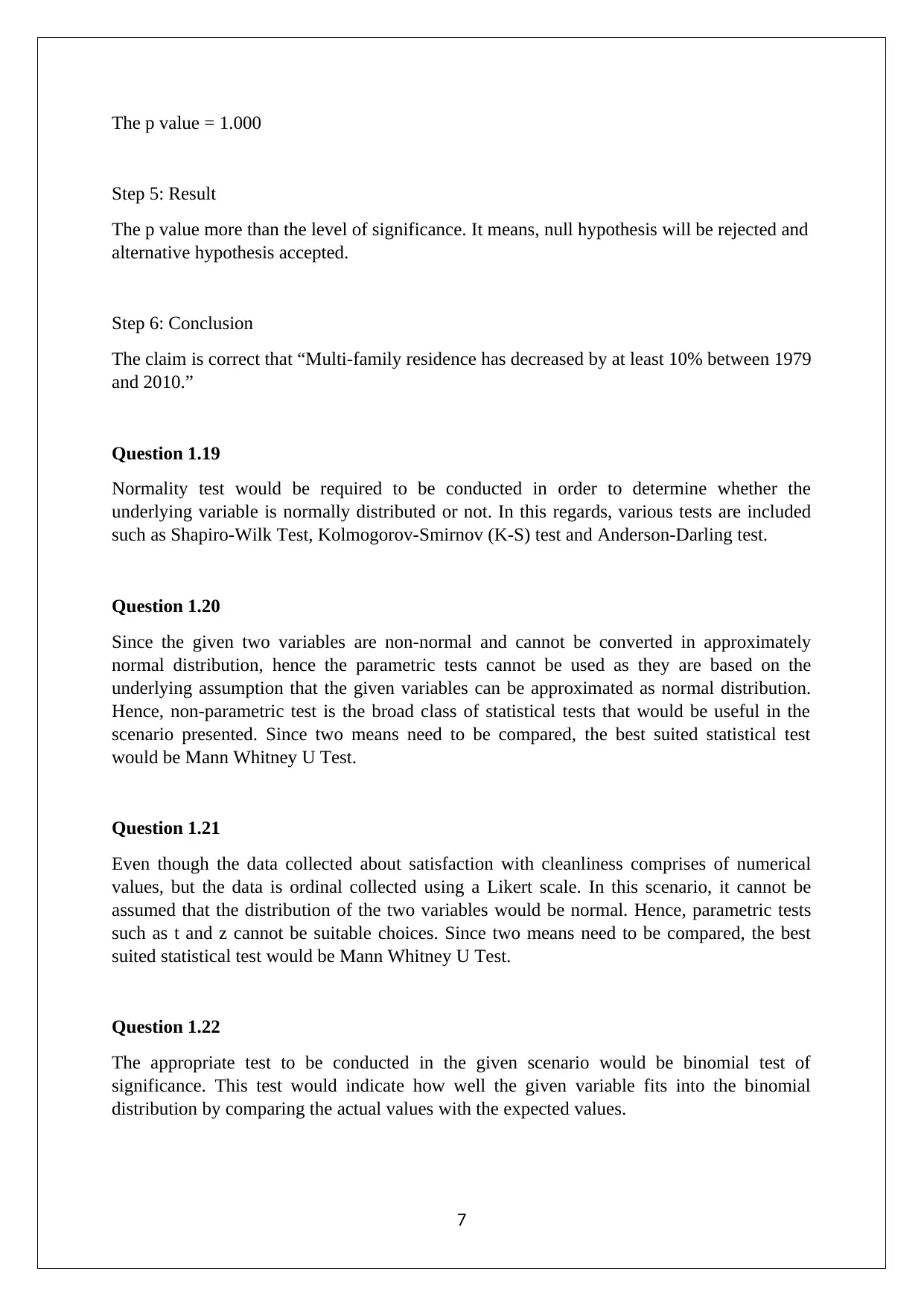
The p value = 1.000
Step 5: Result
The p value more than the level of significance. It means, null hypothesis will be rejected and
alternative hypothesis accepted.
Step 6: Conclusion
The claim is correct that “Multi-family residence has decreased by at least 10% between 1979
and 2010.”
Question 1.19
Normality test would be required to be conducted in order to determine whether the
underlying variable is normally distributed or not. In this regards, various tests are included
such as Shapiro-Wilk Test, Kolmogorov-Smirnov (K-S) test and Anderson-Darling test.
Question 1.20
Since the given two variables are non-normal and cannot be converted in approximately
normal distribution, hence the parametric tests cannot be used as they are based on the
underlying assumption that the given variables can be approximated as normal distribution.
Hence, non-parametric test is the broad class of statistical tests that would be useful in the
scenario presented. Since two means need to be compared, the best suited statistical test
would be Mann Whitney U Test.
Question 1.21
Even though the data collected about satisfaction with cleanliness comprises of numerical
values, but the data is ordinal collected using a Likert scale. In this scenario, it cannot be
assumed that the distribution of the two variables would be normal. Hence, parametric tests
such as t and z cannot be suitable choices. Since two means need to be compared, the best
suited statistical test would be Mann Whitney U Test.
Question 1.22
The appropriate test to be conducted in the given scenario would be binomial test of
significance. This test would indicate how well the given variable fits into the binomial
distribution by comparing the actual values with the expected values.
7
Step 5: Result
The p value more than the level of significance. It means, null hypothesis will be rejected and
alternative hypothesis accepted.
Step 6: Conclusion
The claim is correct that “Multi-family residence has decreased by at least 10% between 1979
and 2010.”
Question 1.19
Normality test would be required to be conducted in order to determine whether the
underlying variable is normally distributed or not. In this regards, various tests are included
such as Shapiro-Wilk Test, Kolmogorov-Smirnov (K-S) test and Anderson-Darling test.
Question 1.20
Since the given two variables are non-normal and cannot be converted in approximately
normal distribution, hence the parametric tests cannot be used as they are based on the
underlying assumption that the given variables can be approximated as normal distribution.
Hence, non-parametric test is the broad class of statistical tests that would be useful in the
scenario presented. Since two means need to be compared, the best suited statistical test
would be Mann Whitney U Test.
Question 1.21
Even though the data collected about satisfaction with cleanliness comprises of numerical
values, but the data is ordinal collected using a Likert scale. In this scenario, it cannot be
assumed that the distribution of the two variables would be normal. Hence, parametric tests
such as t and z cannot be suitable choices. Since two means need to be compared, the best
suited statistical test would be Mann Whitney U Test.
Question 1.22
The appropriate test to be conducted in the given scenario would be binomial test of
significance. This test would indicate how well the given variable fits into the binomial
distribution by comparing the actual values with the expected values.
7
1 out of 7
Related Documents
Your All-in-One AI-Powered Toolkit for Academic Success.
+13062052269
info@desklib.com
Available 24*7 on WhatsApp / Email
![[object Object]](/_next/static/media/star-bottom.7253800d.svg)
Unlock your academic potential
© 2024 | Zucol Services PVT LTD | All rights reserved.
![Statistics Assignment: Hypothesis Testing Solutions - [University]](/_next/image/?url=https%3A%2F%2Fdesklib.com%2Fmedia%2Fimages%2Fbj%2F2a126809566149e6af44fcc81b2e9526.jpg&w=256&q=75)




